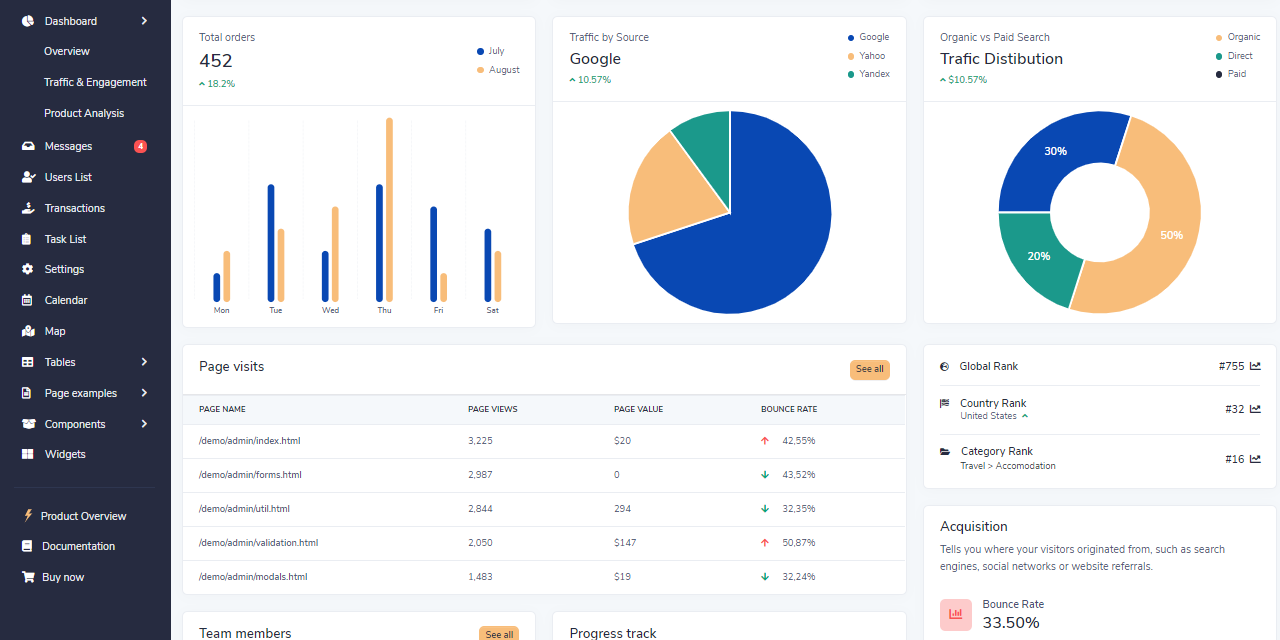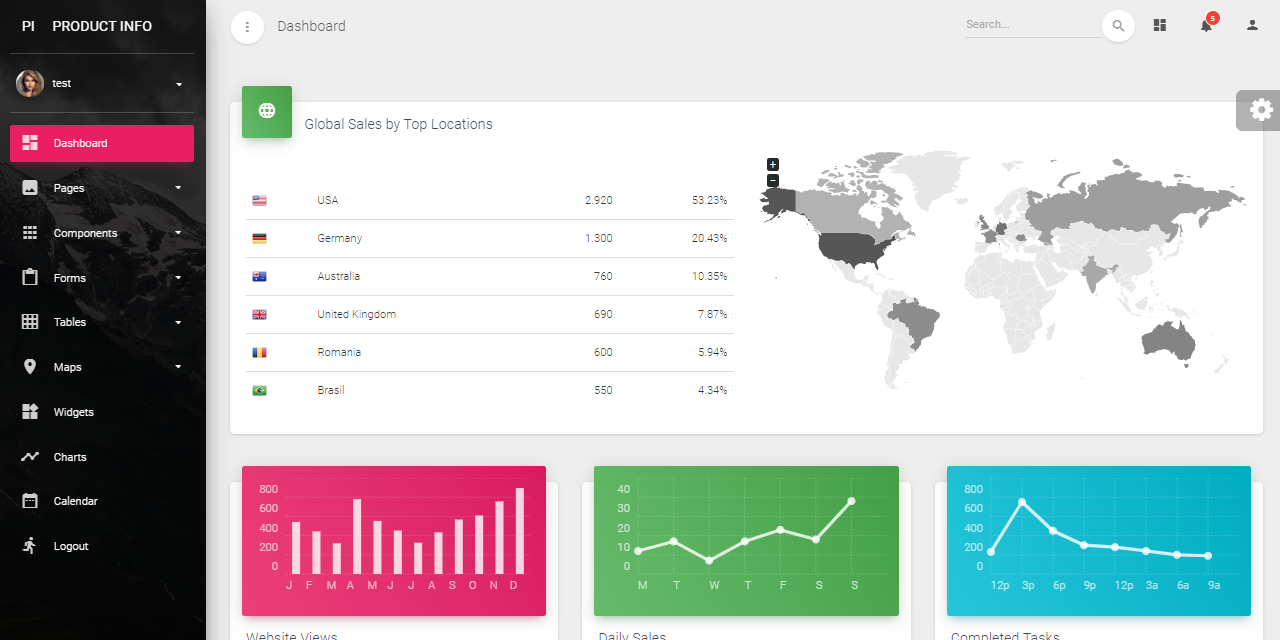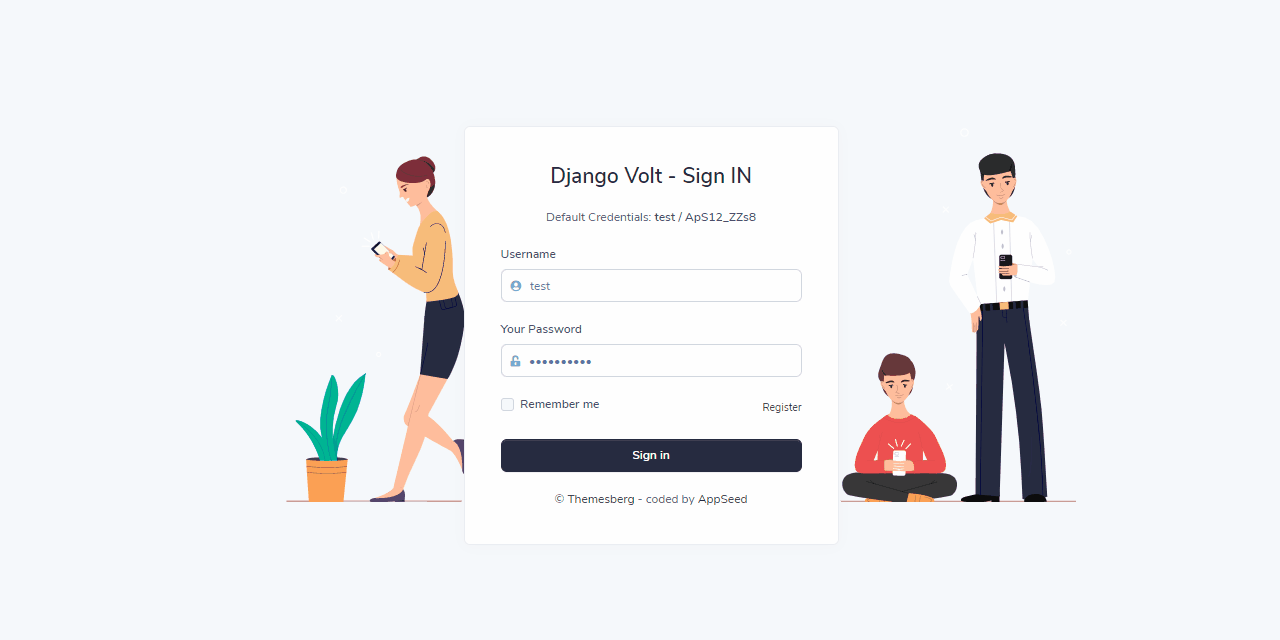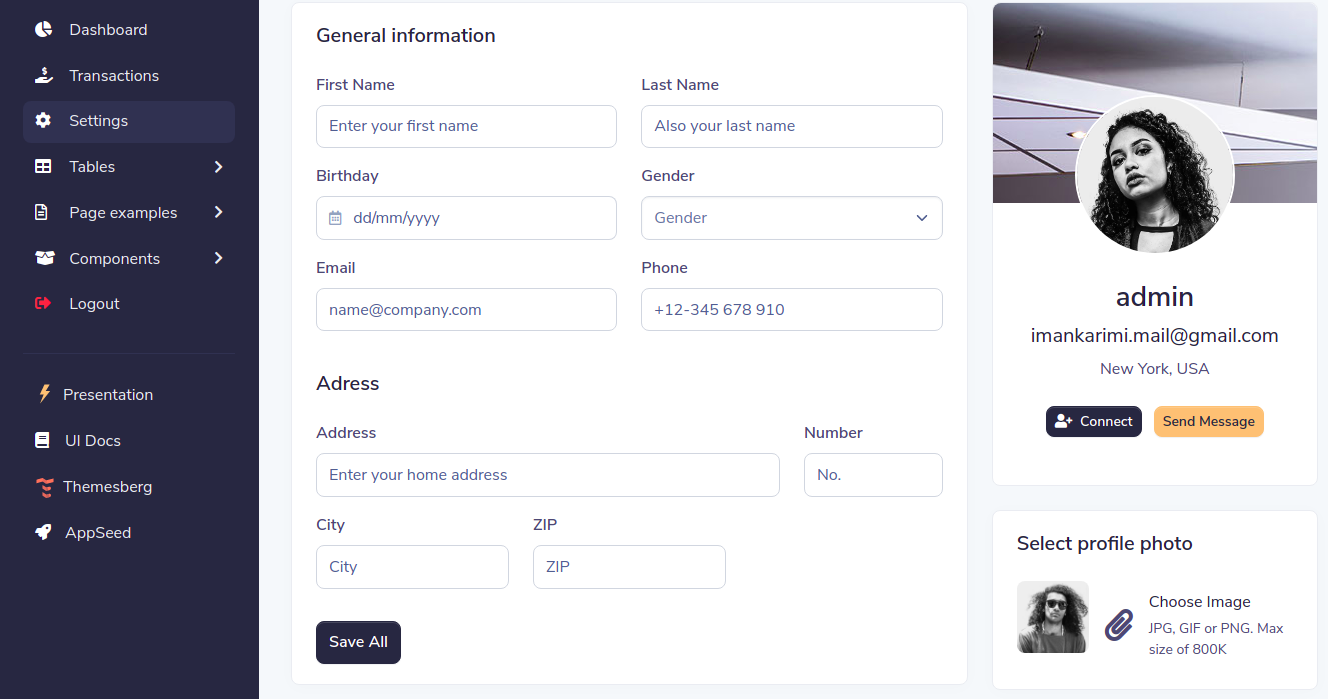Django Sample project that allows registered users to edit their profile. The code is provided on top of Django Volt, a popular open-source Django Template provided by Themesberg and AppSeed.
Features
- UI Kit: Volt Bootstrap 5 by Themesberg
- UI-Ready app, SQLite Database, Django Native ORM
- Session-Based Authentication, Forms validation
- Editable user profile: Name, Surname, Email, Phone, and address
- User Profile Page:
settings.html - Deployment scripts: Docker, Gunicorn / Nginx
- Support via Github (issues tracker) and Discord.
Links
- Django User Profile - Demo - LIVE deployment
- Django Bootstrap 5 Volt - the original starter
PRO versions include Premium UI Kits, Lifetime updates and 24/7 LIVE Support (via Discord)
| Django Volt PRO | Django Datta PRO | Django Material PRO |
|---|---|---|
 |
 |
 |
$ # Get the code
$ git clone https://github.com/app-generator/django-user-profile.git
$ cd django-user-profile
$
$ # Virtualenv modules installation (Unix based systems)
$ virtualenv env
$ source env/bin/activate
$
$ # Virtualenv modules installation (Windows based systems)
$ # virtualenv env
$ # .\env\Scripts\activate
$
$ # Install modules - SQLite Storage
$ pip3 install -r requirements.txt
$
$ # Create tables
$ python manage.py makemigrations
$ python manage.py migrate
$
$ # Start the application (development mode)
$ python manage.py runserver # default port 8000
$
$ # Start the app - custom port
$ # python manage.py runserver 0.0.0.0:<your_port>
$
$ # Access the web app in browser: http://127.0.0.1:8000/Note: To use the app, please access the registration page and create a new user. After authentication, the app will unlock the private pages.
The project is coded using a simple and intuitive structure presented below:
< PROJECT ROOT >
|
|-- core/ # Implements app logic and serve the static assets
| |-- settings.py # Django app bootstrapper
| |-- static/
| | |-- <css, JS, images> # CSS files, Javascripts files
| |-- templates/ # Templates used to render pages
| |
| |-- includes/ # HTML chunks and components
| |-- layouts/ # Master pages
| |-- accounts/ # Authentication pages
| |
| index.html # The default page
| *.html # All other HTML pages
|
|-- authentication/ # Handles auth routes (login and register)
| |-- urls.py # Define authentication routes
| |-- forms.py # Define auth forms
|
|-- app/ # A simple app that serve HTML files
| |-- views.py # Serve HTML pages for authenticated users
| |-- urls.py # Define some super simple routes
|
|-- customers/ # Handles the profile edit <-------- NEW
| |-- __init__.py # Defines App init <-------- NEW
| |-- admin.py # Defines App admin <-------- NEW
| |-- apps.py # Defines App apps <-------- NEW
| |-- forms.py # Defines App forms <-------- NEW
| |-- models.py # Defines App models <-------- NEW
| |-- signals.py # Defines App signals <-------- NEW
| |-- tests.py # Defines App tests <-------- NEW
| |-- urls.py # Defines App routes <-------- NEW
| |-- views.py # Defines App views <-------- NEW
|
|-- requirements.txt # Development modules - SQLite storage
|-- .env # Inject Configuration via Environment
|-- manage.py # Start the app - Django default start script
|
|-- ************************************************************************The bootstrap flow
- Django bootstrapper
manage.pyusescore/settings.pyas the main configuration file core/settings.pyloads the app magic from.envfile- Redirect the guest users to Login page
- Unlock the pages served by app node for authenticated users
This section describes the coding process for this feature that allows authenticated users to update their profiles.
In this section, the user can change profile information, including name, email, avatar, ... etc.
To do this, we create a new app called customers, then create a model named Profile to store user information.
This module will manage the user profile information by defining a new model, form, and view. Authenticated users can also upload their avatar.
$ python manage.py startapp customerscustomers/models.py:
class Profile(models.Model):
# Managed fields
user = models.OneToOneField(User, related_name="profile", on_delete=models.CASCADE)
avatar = models.ImageField(upload_to="customers/profiles/avatars/", null=True, blank=True)
birthday = models.DateField(null=True, blank=True)
gender = models.PositiveSmallIntegerField(choices=GENDER_CHOICES, null=True, blank=True)
phone = models.CharField(max_length=32, null=True, blank=True)
address = models.CharField(max_length=255, null=True, blank=True)
number = models.CharField(max_length=32, null=True, blank=True)
city = models.CharField(max_length=50, null=True, blank=True)
zip = models.CharField(max_length=30, null=True, blank=True)
@property
def get_avatar(self):
return self.avatar.url if self.avatar else static('assets/img/team/default-profile-picture.png')get_avatar: In this property, if the avatar value is not provided by the user, the default value is used.
Create related form to show inputs & store data. The ProfileForm will be defined in the customers/forms.py using a definition as below:
from django import forms
from customers.models import Profile
class ProfileForm(forms.ModelForm):
first_name = forms.CharField(max_length=255)
last_name = forms.CharField(max_length=255)
email = forms.EmailField()
class Meta:
model = Profile
fields = '__all__'
exclude = ['user']Note: We have three fields (first_name, last_name, email) that are outside the profile model (they are in the user model). We need to add these three fields to our form.
- create
ProfileViewincustomers/views.py:
from customers.forms import ProfileForm # import the used form
from customers.models import Profile # import the Profile Model
class ProfileView(View):
profile = None
def dispatch(self, request, *args, **kwargs):
self.profile, __ = Profile.objects.get_or_create(user=request.user)
return super(ProfileView, self).dispatch(request, *args, **kwargs)
def get(self, request):
context = {'profile': self.profile}
return render(request, 'customers/profile.html', context)
def post(self, request):
form = ProfileForm(request.POST, request.FILES, instance=self.profile)
if form.is_valid():
profile = form.save()
# to save user model info
profile.user.first_name = form.cleaned_data.get('first_name')
profile.user.last_name = form.cleaned_data.get('last_name')
profile.user.email = form.cleaned_data.get('email')
profile.user.save()
return redirect('profile')dispatch method: In this section, if the user does not have a profile, it will be created and the value of the profile object will set in the profile field.
The template that handles the user input is defined in customers/profile.html file.
<form action="{% url 'profile' %}" method="POST" enctype="multipart/form-data">
{% csrf_token %}
<div>
<label for="first_name">First Name</label>
<input name="first_name" class="form-control" id="first_name" type="text"
placeholder="Enter your first name" value="{{ profile.user.first_name }}"
required>
</div>
<div>
<label for="last_name">Last Name</label>
<input name="last_name" class="form-control" id="last_name" type="text"
placeholder="Also your last name" value="{{ profile.user.last_name }}"
required>
</div>
<label for="gender">Gender</label>
<select name="gender" class="form-select mb-0" id="gender"
aria-label="Gender select example">
<option selected>Gender</option>
{% for key, value in profile.GENDER_CHOICES %}
<option value="{{ key }}"
{% if profile.gender == key %}selected{% endif %}>{{ value }}</option>
{% endfor %}
</select>
<!-- And the rest of the fields -->
</form>Note: Make sure there is
enctype="multipart/form-data"attribute in the form tag to upload the avatar.
Activate the routing for customers app by edit the customers/urls.py file with the following code:
from django.urls import path
from customers import views
urlpatterns = [
path('profile/', views.ProfileView.as_view(), name='profile'),
]Update core/urls to include customers urls:
from django.conf import settings
from django.contrib import admin
from django.conf.urls.static import static
from django.urls import path, include
urlpatterns = [
path('admin/', admin.site.urls), # Django admin route
path('customers/', include("customers.urls")), # Django customers route
# ...
]
# to support and show media & static files in developer mode
if settings.DEVEL:
urlpatterns += static(settings.MEDIA_URL, document_root=settings.MEDIA_ROOT)
urlpatterns += static(settings.STATIC_URL, document_root=settings.STATIC_ROOT)- Django - the official website
- More Django Templates provided by Themesberg
- More Django Dashboards provided by AppSeed
Django Template Volt - Provided by Themesberg and AppSeed.

